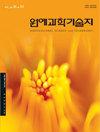Effect of Soil Irrigation Starting Point Using Tensiometer on Growth and Water Use of Cucumber in Greenhouse
IF 0.8
4区 农林科学
Q3 HORTICULTURE
Korean Journal of Horticultural Science & Technology
Pub Date : 2021-04-01
DOI:10.7235/HORT.20210021
引用次数: 0
Abstract
This experiment was conducted to investigate the effect of the soil irrigation starting point on the growth and water use efficiency of cucumber at each growth stage in a greenhouse. Cucumber (Cucumis sativus L.) ‘Chungchun’ grafting seedlings were transplanted on April 20, 2020 and cultivated until July 5, 2020 in a polyethylene greenhouse in Chuncheon-si, Gangwon-do. Soil irrigation starting point using a tensiometer were treated in 10-10-10 (T1), 10-10-20 (T2), 20-10-10 (T3), 20-10-20 (T4), and a control. The total amounts of irrigation, growth, yield and water use efficiency were measured. The average daily soil water tension (kPa) was 8.3 for T1, 9.2 for T2, 10.7 for T3, 10.2 for T4, and 5.9 for the control. The total amount of irrigation supplied was from 53,322 mL (T1) to 59,206 mL (T4), there was no difference between treatments. The average daily irrigation amount per plant was 773 mL (T1), 787 mL (T2), 780 mL (T3), and 858 mL (T4). The total number and intervals of the irrigations were not different from 86 times (T3) to 99 times (T1) and 0.7days. In the control, the daily average amount of irrigation was 1,525 mL, and the total number of irrigations was 50. In the control, the average amount of irrigation was twice that of the treatments (T1, T2, T3, and T4), and the number of irrigations was reduced by more than 40%. On the 43rd day of treatment, plant height, number of nodes, leaf width, and number of leaves were highest in the control, and the lowest plant height was in T3 and T4 treatments. There was no significant difference土壤灌溉起点张力仪对温室黄瓜生长和水分利用的影响
本试验研究了土壤灌溉起点对温室黄瓜各生育期生长和水分利用效率的影响。黄瓜(Cucumis sativus L.)“春春”嫁接苗于2020年4月20日移植,并在江原道春川寺的聚乙烯温室中培育至2020年7月5日。使用张力计对10-10-10(T1)、10-10-20(T2)、20-10-10(T3)、20-10-20(T4)和对照组的土壤灌溉起点进行处理。测量了灌溉总量、生长、产量和用水效率。T1的平均日土壤水张力(kPa)为8.3,T2为9.2,T3为10.7,T4为10.2,对照为5.9。灌溉总量为53322 mL(T1)至59206 mL(T4),两个处理之间没有差异。每株植物的平均每日灌溉量分别为773 mL(T1)、787 mL(T2)、780 mL(T3)和858 mL(T4)。灌溉次数和间隔时间在86次(T3)至99次(T1)和0.7天之间没有差异。对照组的日平均灌溉量为1525mL,灌溉次数为50次。对照组的平均灌溉量是处理组(T1、T2、T3和T4)的两倍,灌溉次数减少了40%以上。处理第43天,对照株高、节数、叶宽和叶片数最高,T3和T4处理株高最低。没有显著差异
本文章由计算机程序翻译,如有差异,请以英文原文为准。
求助全文
约1分钟内获得全文
求助全文
来源期刊
CiteScore
2.00
自引率
0.00%
发文量
0
审稿时长
1 months
期刊介绍:
Horticultural Science and Technology (abbr. Hortic. Sci. Technol., herein ‘HST’; ISSN, 1226-8763), one of the two official journals of the Korean Society for Horticultural Science (KSHS), was launched in 1998 to provides scientific and professional publication on technology and sciences of horticultural area. As an international journal, HST is published in English and Korean, bimonthly on the last day of even number months, and indexed in ‘SCIE’, ‘SCOPUS’ and ‘CABI’. The HST is devoted for the publication of technical and academic papers and review articles on such arears as cultivation physiology, protected horticulture, postharvest technology, genetics and breeding, tissue culture and biotechnology, and other related to vegetables, fruit, ornamental, and herbal plants.

 求助内容:
求助内容: 应助结果提醒方式:
应助结果提醒方式:


